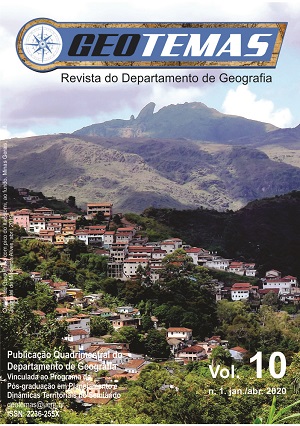Experiments with soil morphological characteristics as a didactic resource for soil teaching
Keywords:
Soil teaching, Morphological characteristics, Didactic resource, Distance EducationAbstract
Soil is a finite natural resource that provides important ecosystem services for societies, such as food production and water purification. Formed by minerals, organic matter, water and air. It is fundamental for the maintenance of terrestrial ecosystems. Due to its importance, soil education should provide a theoretical and practical basis that allows the student to understand its origin processes, functions and properties, seeking to promote environmental awareness about the importance of soil conservation for present and future generations. Experiments with soil morphological characteristics show themselves as important didactic resource for teaching soil in Basic Education. In view of the above, this article report the development of activities with students from graduation in Geography in distance learning in a workshop realized during the I Simpósio Integrado em EaD do Cariri Paraibano. The aim of this article, is to promote an experimentation with soils like didatics resources on the elementary and high school. The results showed that the experiments are effective for teaching soil, in view that they allowed the understanding of different attributes of soil morphology. Thus, the tests proved as facilitators in learning of the morphology and dynamic of soil, at the same time that they allowed to unite theory and practice.
Downloads
References
BELTRíO, B. A.; MORAIS, F. M.; MASCARENHAS, J. C.; MIRANDA, J. L. F.; JÚNIOR, L. C. S.; MENDES, V. A. (org.). Projeto cadastro de fontes de abastecimento por água subterrânea: diagnóstico do município de Livramento, estado da Paraíba. Recife: CPRM/PRODEEM, 2005. 10 p.
CAMPOS, J. O.; MARINHO, J. O.; REINALDO, L. R. L. R. Experimentos como recursos didáticos para Educação em Solos no Ensino de Geografia. Revista Ensino de Geografia (Recife), v. 2, n. 1, p. 166-185, jan./abr. 2019. DOI: https://doi.org/10.38187/regeo2019.v2n1id240694
CUNHA, J. E.; ROCHA, A. S.; TIZ, G. J. MARTINS, V. M. Práticas pedagógicas para ensino sobre solos: aplicação í preservação ambiental. TERRÆ DIDATICA, v. 9, n.2, p.74-81, 2013. DOI: https://doi.org/10.20396/td.v9i2.8637395
FRASSON, V. R.; WERLANG, M. K. Ensino de Solos na Perspectiva da Educação Ambiental: Contribuições da Ciência Geográfica. Geografia: Ensino & Pesquisa, Santa Maria, v. 1 4, n. 1, p. 94- 99, 2010. Disponível em: https://www.passeidireto.com/arquivo/25153646/ensino-de-solos-na-pespectiva-daeducacao-ambiental-contribuicoes-da-ciencia-geografica1. Acesso em: 21 jan. 2020.
GOULART, A. V.; SILVA, C. C. F.; WABER, M. A. Importância das aulas práticas no ensino de solos. In: SALíO INTERNACIONAL DE ENSINO, PESQUISA E EXTENSíO,8, 2016, Uruguaiana – RS. Anais..., Uruguaiana – RS: Unipampa, 2016, p. 1-2. Disponível em: http://publicase.unipampa.edu.br/index.php/siepe/article/view/19281. Acesso em: 15 fev. 2020.
IBGE – Instituto Brasileiro de Geografia e Estatística. Estimativas da população residente para os municípios e para as unidades da federação com data de referência em 1º de julho de 2019: notas metodológicas. Rio de Janeiro: IBGE. 2019. 16 p. Disponível em: https://biblioteca.ibge.gov.br/visualizacao/livros/liv101662.pdf. Acesso em: 04 jan. 2020.
LEPSCH, I. F. 19 Lições de Pedologia. São Paulo, Oficina de textos, 2011.
LIMA, G. A. C; ARAÚJO, P. M; REINALDO, L. R. L. R; XAVIER, R. A. Textura do Solo: Importância da Realização de Atividades Práticas no Ensino de Geografia. Revista Tamoios, São Gonçalo (RJ), v. 11, n. 2, p. 177-188, jul/dez. 2015. DOI: https://doi.org/10.12957/tamoios.2015.15318
LIMA, M. R. Noções de morfologia do solo. In: LIMA, V. C.; LIMA, M. R.; MELO, V. F. (ed.). O solo no meio ambiente: abordagem para professores do ensino fundamental e médio e alunos do ensino médio. Curitiba: Universidade Federal do Paraná, Departamento de Solos e Engenharia Agrícola, 2007. p. 17-26.
LIMA, M. R. O solo no ensino de ciências no nível fundamental. Ciência & Educação, v. 11, n. 3, p. 383-395, 2005. DOI: https://doi.org/10.1590/S1516-73132005000300004
LIMA, M. R. Perfil e morfologia do solo. In: LIMA, M. R. (org.). Conhecendo os solos: abordagem para educadores do ensino fundamental na modalidade í distância. Curitiba: Universidade Federal do Paraná, Departamento de Solos e Engenharia Agrícola, 2014. p. 51-68.
MUGGLER, C. C.; PINTO SOBRINHO, F. A.; MACHADO, V. A. Educação em Solos: princípios, teoria e métodos. R. Bras. Ci. Solo, v. 30, n.4, p.733-740, 2006. DOI: https://doi.org/10.1590/S0100-06832006000400014.
RESENDE, M.; CURI, N.; CORRÊA, G. F; RESENDE, F. B. Pedologia: base para distinção de ambientes. 4. ed. Viçosa: NEPUT, 2002.
SACRAMENTO, A. C. R.; FALCONI, S. Educação Geográfica e Ensino de Solos: uma experiência em sala de aula. Revista Geográfica de América Central, Número Especial, EGAL, p. 1-15, 2011. Disponível em: https://core.ac.uk/download/pdf/48869437.pdf. Acesso em: 08 jan. 2020.
Downloads
Published
How to Cite
Issue
Section
License
Authors who submit their manuscripts to Geotemas declare that the work is an original article and has not been submitted for publication, in full or in part, in another national or international scientific journal or in another circulation vehicle. The authors also declare that they agree with the transfer of the copyright of the referred article to the magazine Geotemas (University of the State of Rio Grande do Norte), allowing for later publications, as long as the source of its publication is assured. Finally, they assume public responsibility for the article, being aware that any charges arising from a claim by third parties regarding the authorship of the work may apply to them.



















